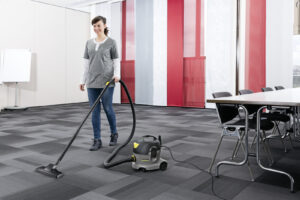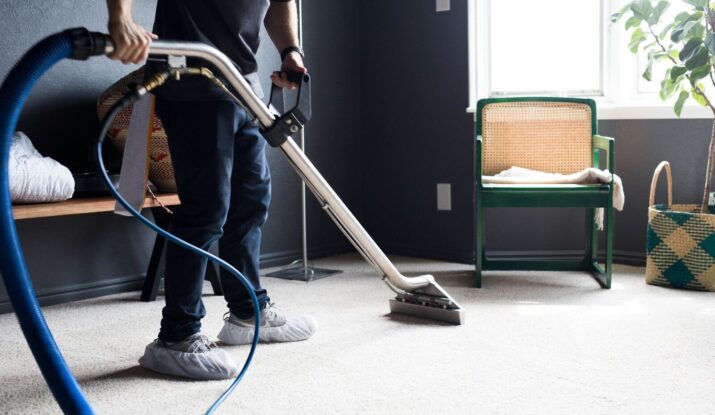Carpet cleaning is an essential part of maintaining a clean and vibrant home environment. While carpet cleaning services Melbourne offer a convenient solution, there’s something particularly satisfying about tackling the task yourself.
DIY carpet cleaning not only saves money but also helps you remove spills and stains immediately, ensuring your carpets remain in pristine condition. Whether you want to eliminate a spill or simply conduct routine maintenance, understanding the best practices and methods for DIY carpet cleaning is crucial.
In this guide, we’ll explore various techniques and tips for cleaning your carpets, with or without a machine, to help them look as good as new.
Preparing to Clean Your Carpet
Before diving into the world of DIY carpet cleaning, it’s crucial to gather the appropriate supplies and ensure your carpet can handle the cleaning regimen you have in mind. Proper preparation will lead to a more effective and safe cleaning process.
Supplies You’ll Need
To start your carpet cleaning journey, you’ll require various tools and cleaning agents, each with a different purpose. Ensure you have the following supplies on hand:
- Vacuum: A critical component for removing surface dirt and preparing the carpet for deeper cleaning.
- Carpet-cleaning machine (optional): For a more thorough clean, especially for deep-set dirt and stains.
- Baking soda: A versatile agent that is helpful in odour removal and is a gentle abrasive.
- White vinegar: Excellent for DIY cleaning solutions due to its acidity, which helps break down stains.
- Hydrogen peroxide: Useful for tackling more stubborn stains, like blood.
- Carpet cleaner: A commercially available solution or a homemade blend for cleaning carpet fibres.
- Rug brush: To manually agitate the carpet fibres and loosen dirt.
- Spray bottle: To apply homemade cleaning solutions evenly.
- Microfiber cloths: For blotting and gently working on stains without damaging carpet fibres.
Check Your Carpet’s Suitability for Cleaning
Not all carpets are created equal, and understanding the material and construction of your carpet is important before proceeding with any cleaning activity.
Wall-to-wall carpeting and area rugs require different approaches. For instance, a vintage or delicate rug might need professional cleaning or a specialised hand-washing procedure. Here’s how to ascertain if your carpet can undergo the cleaning process you plan:
- Read labels and manufacturer’s instructions:These often provide crucial insights into what cleaning methods are safe for your carpet.
- Perform a spot test:Choose a small, inconspicuous carpet area to test your cleaning solution. Apply a small amount, wait a few hours, and check for any adverse reactions, such as discolouration or texture change.
Routine Carpet Cleaning
A regular cleaning schedule prolongs the life of your carpet, ensuring it looks fresh and hygienic. Let’s dive into the frequency of cleaning, vacuuming techniques, and spot-cleaning tips for routine carpet maintenance.
How Often to Clean?
The frequency of your carpet cleaning depends largely on its use and exposure to dirt, dust, and spillages. As a rule of thumb:
- Vacuuming: Should be done once or twice a month to remove surface dirt and dander, helping maintain the carpet’s appearance and prevent buildup.
- Deep Cleaning: Conduct a deep cleaning session every few months, or more frequently if the carpet is heavily used or in areas with high foot traffic.
Vacuuming Techniques
Vacuuming seems like a simple task, but using the right techniques can significantly enhance its effectiveness:
- Choose a vacuum with a suction attachment: This is more effective at extracting dirt from the carpet fibres compared to standard vacuums.
- Regular and thorough vacuuming: Ensure all areas are covered, paying extra attention to high-traffic zones and under furniture.
- Vacuum in multiple directions: This helps to lift and remove more dirt by agitating the carpet fibres more effectively.
Spot Cleaning Tips
Accidents happen, and knowing how to promptly and effectively tackle spills can save your carpet from permanent stains. Here are some tips for spot cleaning:
- Act quickly: The sooner you address spills, the less likely they are to set in and become permanent.
- Blot, don’t rub: Gently blot spills with a clean, dry cloth or paper towel. Rubbing can push the spill deeper into the fibres.
- Use the right cleaner: Choose a cleaning solution that’s suited for the type of stain and your carpet’s material. For organic stains like pet accidents, a solution of white vinegar and water can be effective. For oil-based stains, you might need a specialised carpet cleaner.
Dealing with Tough Stains
Dealing with tough stains on carpets is a common challenge for homeowners. Understanding how to effectively remove different types of stains can help maintain the look and longevity of your carpet. Let’s explore methods to rid your carpet of pet hair and stains, as well as how to handle more stubborn substances like blood, paint, and wine.
1. Removing Pet Hair and Stains
Pet hair and stains are inevitable in homes with furry friends. A simple yet effective method to remove pet hair involves sprinkling baking soda over the carpet, allowing it to lift the hair from the fibres, and then vacuuming it up.
For pet stains, such as urine, it’s important to blot up as much liquid as possible using a paper towel. A mixture of equal parts white vinegar and warm water can be sprayed onto the area to eliminate odours. After allowing it to sit briefly, blot the mixture dry with a paper towel.
2. Getting Blood, Paint, and Wine Out of the Carpet
Blood, paint, and wine can cause daunting stains on carpets, but they are not impossible to remove. For blood stains, a solution composed of two parts hydrogen peroxide and one part dish soap can be applied to the stain. Gently blot with a cloth to lift the blood. Cold water mixed with white vinegar is an alternative method, especially for dried stains.
Spilled wine requires quick action. Initially, absorb as much liquid as possible, then apply salt or baking powder to absorb the remainder. Vacuum after a few minutes. If the stain persists, a specialised carpet-cleaning solution can be used.
Removing paint from carpets depends on whether it is water-based or oil-based. Water-based paint can often be blotted up, then gently scraped off or treated with rubbing alcohol. Oil-based paint may require paint thinner and should be handled carefully to avoid damaging the carpet.
Deep Cleaning Your Carpet
Apart from spot cleaning, deep cleaning your carpet regularly ensures it remains in prime condition, free from deeply ingrained dirt and allergens.
Deep Cleaning by Hand
For those who prefer the manual approach or lack access to a machine, deep cleaning by hand is viable. Start by liberally sprinkling baking soda over the carpet to loosen dirt and deodorise. Prepare a solution of carpet shampoo and warm water in a spray bottle and apply it to the carpet.
Using a brush, gently agitate the carpet fibres before blotting the area with a clean cloth. A final rinse with warm water, followed by thorough blotting, will complete the cleaning process. While labour-intensive, this method can be cost-effective and gratifying.
Using a Carpet-Cleaning Machine

For a more thorough cleaning, a carpet-cleaning machine is beneficial. These machines work by applying a cleaning solution onto the carpet and then extracting the dirty water, effectively removing dirt and stains from deep within the carpet fibres. Before cleaning, vacuum the area to remove loose debris. Pre-treat any stubborn stains.
Fill the machine with the appropriate cleaning solution and water, then clean the carpet, working in sections and making sure not to saturate the carpet. Let the carpet dry completely before walking on it or replacing furniture.
When to Consider Hiring a Professional?
While DIY methods are effective for regular maintenance and minor stains, certain situations may warrant the expertise of professional carpet cleaners. If your carpet is severely stained, has accumulated years of dirt, or is a delicate antique that requires specialised care, hiring professionals can be a wise choice.
Professional cleaning services have access to high-grade equipment and cleaning solutions that can deeply sanitise and refresh your carpet beyond the capabilities of most homeowner-grade machines. Additionally, if your home has extensive carpeting, the time and effort saved can be significant. Remember, while professional cleaning involves upfront costs, the investment can extend the life and appearance of your carpet, saving money in the long run.
Aftercare and Maintenance
Maintaining your carpet after a thorough cleaning is crucial for extending its life and keeping it looking fresh. Proper aftercare involves a combination of drying techniques and regular maintenance practices that ensure your carpet remains in top condition.
Drying Your Carpet Post-Cleaning
Ensuring your carpet dries thoroughly after a deep clean is important to prevent mould and mildew growth, which can cause odours and potential health issues. Here are strategies to facilitate effective drying:
- Ventilation: Open windows and doors to increase airflow across the carpeted area. This method is the most natural way to speed up drying times.
- Fans: Use standing or ceiling fans to circulate air more efficiently. Position fans so that air moves across the surface of the carpet for best results.
- Dehumidifiers: These can be particularly helpful in humid environments by pulling moisture out of the air and, thereby from your carpet.
- Heat: While direct heat should be avoided to prevent shrinkage and damage, maintaining a warm temperature in the room supports faster drying.
Allow your carpet to dry completely, usually 4 to 6 hours, before replacing furniture or walking on it. This patience pays off in preserving your carpet’s quality and avoiding dampness-related issues.
Regular Maintenance Tips
Regular upkeep can significantly lower the need for deep cleaning sessions and prolong your carpet’s life. Below are essential tips for maintaining your carpet’s appearance and health:
- Frequent Vacuuming: Vacuum at least once or twice a month to remove dirt, dust, and allergens. High-traffic areas may need more frequent attention. Choose a vacuum with a suction attachment for deeper cleaning.
- Immediate Stain Treatment: Attend to spills and stains immediately to prevent them from setting and becoming more challenging to remove.
- Use Doormats: Place doormats at all entrances to minimise the amount of dirt and moisture tracked onto the carpet.
- Rotate Rugs: If you have area rugs, rotate them annually to ensure even wear and tear.
- Professional Cleaning: Even with diligent DIY care, consider having your carpet professionally cleaned once a year to tackle stubborn dirt and debris deeply embedded in the fibres.
- Avoid Steam Cleaning: For certain types of carpets, especially wool rugs, steam cleaning can be damaging. It’s best to follow the care instructions specific to your carpet’s material.
Conclusion
Cleaning carpets in your home doesn’t have to be daunting. With the right tools and a bit of patience, you can effectively remove stains, eliminate odours, and restore your carpet’s appearance. Whether you opt for DIY methods using household items like baking soda and vinegar, or invest in a carpet-cleaning machine for a deeper clean, the key is regular maintenance and prompt action on spills.
And, if the task seems too overwhelming or if the carpet is too delicate, hiring professional carpet cleaning in Melbourne may be your best decision. Carpet cleaning experts possess the knowledge and equipment to deep-clean without causing damage.
Total Cleaning Melbourne can assist you in deep cleaning your carpets and bringing back their shine. Whether you need help with residential or commercial carpet cleaning, we have got you covered. Reach out to our team today and let us revitalise your space!

